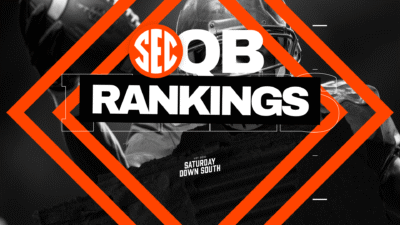Harbaugh’s salary shines spotlight on college football arms race
By Jordan Cox
Published:
New Michigan head coach Jim Harbaugh is not making $8 million per year, but he’s not making much less.
Harbaugh signed a seven-year deal worth $5 million annually with a $2 million signing bonus. The former Wolverines quarterback is eligible for 10 percent increases after three and five years. His compensation package also includes a number of incentives that could add up to $1.3 million.
The maximum salary Harbaugh can make in his first year, only from base salary, his signing bonus and incentives?
$8.3 million.
That figure is eye-popping to some, it’s becoming the norm to others. The arms race in college football — both in terms of facilities and coaches’ salaries — has no end in sight, especially as long as the sport continues to produce revenue at historic levels. With today marking the end of the 2014 calendar year, five SEC head coaches currently make $4 million or more per year. With the calendar flipping to 2015, that number will increase to six. Auburn head coach Gus Malzahn will earn $4.1 million in 2015, up from his $3.8 million salary this year.
Harbaugh won’t earn the maximum available in his contract, but he will be the first or second highest paid coach in the Big Ten and one of just a handful of coaches nationally who rake in $5 million-plus annually. The SEC’s Nick Saban and Kevin Sumlin have already joined that club.
Harbaugh will earn more than double what Michigan paid the now-fired Brady Hoke. Hoke earned $2.3 million in 2014 before being let go on Dec. 3. Even Rich Rodriguez, Michigan’s head coach prior to Hoke, earned just $2.5 million annually.
Depending on your point-of-view, the escalation of coaching salaries in recent years is the evidence that big-business is ruining collegiate athletics or its the national progression of the market. More revenue equals better compensation for those responsible for the income.
“It’s simple, really,” agent Neil Cornrich, who represents high-profile coaches such as Bob Stoops and Kirk Ferentz, told the Washington Post. “As long as revenues from college football continue to grow, all the numbers will follow.”
Cornrich — who should be lauded for negotiating Ferentz’s rock-solid deal at Iowa — has a point. Because the revenue is there, programs can pay coaches exorbitant sums of money. To keep the money there, they do pay coaches more than what many people believe college football coaches are simply worth.
The Post reports, citing an NCAA study released last April, that only 20 Football Bowl Subdivision schools finished in the black during the 2013 fiscal year. Meanwhile, USA Today’s coaching salary database shows coaching salaries have doubled since 2006.
Yes, less than a decade later and this is where we find ourselves. And for those asking the rational question in the progression, “When will a coach make $10 million?,” I predict it will be before 2016. Within the confines of USA Today’s database — 2006 to 2016 — we will have skyrocketed from the highest-paid coaches making in the range of $1.5 million to $3 million annually to now the highest-paid coaches making in the range of $7 million to $10 million per.
And if you think a $10 million man is far off, you’re wrong. Texas reportedly offered Saban a 10-year, $100 million deal last offseason before hiring former Louisville head coach Charlie Strong, who made $5 million in 2014.
Not every school can afford to pay its football coach in that arena, but such is life in major college athletics these days. It’s what has caused such a divide over player compensation, and it’s what has triggered so many of the lawsuits in which the NCAA or its member institutions now find themselves.
The money is there for Power 5 schools, however. Television rights fees have sent revenue for the power conferences through the stratosphere. The SEC Network launched as the most successful cable network in history, in more than 90 million homes. First-year revenue estimates from the network are believed to be in the $500 million to $600 million range. If accurate, once divided up amongst the 14 SEC programs, it would add out to an additional $35 million per school.
Within the current structure of collegiate athletics, no one person is more responsible for the bulk of that revenue than head coaches.
“Am I surprised they [the salaries] are going up? Not when revenues are going up,” Cornrich said. “If revenues go down, the salaries will go down. These are businesses that are operated by universities, but they’re very dependent on the unique job skills of certain coaches. There are tons of people who want to do it. There are very few who can do it. You need one of those tremendously prolific people – people like Bob Stoops and Kirk Ferentz – who enhances a school’s brand and creates so much value.”
So Harbaugh isn’t the richest coach in college football history. But at this rate, it won’t take long to find out who will be.
After living in Birmingham, Ala., Jordan left the ground zero of SEC Nation to head south to Florida to tell the unique stories of the renowned tradition of SEC football. In his free time, his mission is to find the best locales around.






